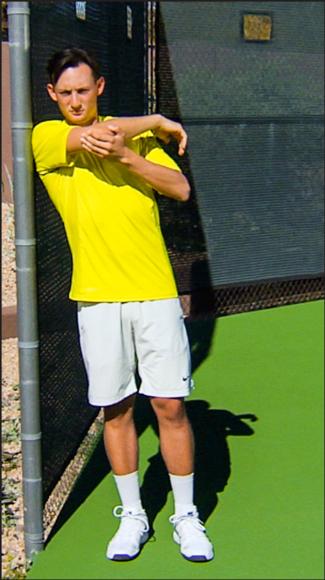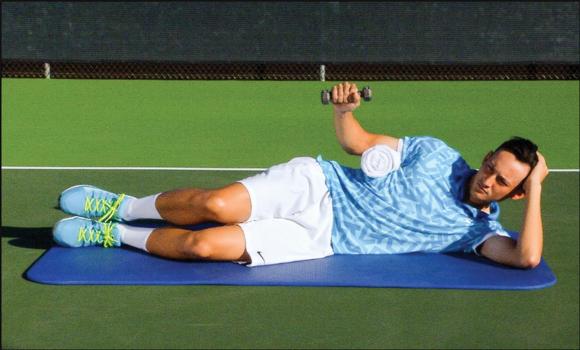Shoulder Injuries in Tennis
This is an excerpt from Complete Conditioning for Tennis 2nd Edition With HKPropel Online Video by Mark Kovacs,E Paul Roetert,Todd S Ellenbecker.
The most common injury site in the shoulder is not the rotator cuff muscles themselves but rather the tendons that attach these muscles to the upper arm. There is not a lot of space inside the shoulder. When muscles fatigue or improper technique is used, it is very easy for one of the rotator cuff tendons that pass through this space to get pinched. When this happens over and over again, it can injure the tendon. The labrum or cartilage in the shoulder socket also can become injured (torn) in overhead athletes, especially those with very loose shoulders and poor rotator cuff strength and shoulder stability. Many of the shoulder injuries seen in tennis can be prevented with a proper stretching and strengthening program.
Stretches to Prevent Shoulder Injuries
The two most important shoulder stretches for tennis players are the cross-arm stretch and the sleeper stretch. Research shows that using these stretches as part of a regular program will improve the range of motion of internal rotation.
Preventive Shoulder Stretches
As with any stretch, perform them after tennis play and complete 2 or 3 repetitions of each stretch, holding each for 20 to 30 seconds. This will improve or maintain flexibility in the shoulder.
Posterior Shoulder Stretch (Cross-Arm Stretch)
Focus
Improve flexibility of the muscles in the back of the shoulder and back of the shoulder joint capsule.
Procedure
- Stand next to a doorway or fence. Raise your racket arm to shoulder level. Brace the side of your shoulder and shoulder blade against the wall or fence to keep the shoulder blade from sliding forward when you begin the stretch.
- Using the other hand, grab the outside of the elbow of your racket hand and pull your arm across your chest (figure 12.3). You should feel the stretch in the back of your shoulder.
- Hold the position, then switch sides.
Note
If you feel a pinching sensation in the front of your shoulder, discontinue this stretch and use the sleeper stretch to accomplish a similar stretch for this portion of the shoulder.

Cross-arm stretch.
Strengthening Exercises to Prevent Shoulder Injuries
Increasing muscular endurance and building a base level of strength in the rotator cuff and upper back should be the goals of any shoulder-strengthening program. The following exercises can be used to strengthen the back, or posterior part, of the rotator cuff. Perform each of these exercises slowly and with proper form.
Begin by performing these exercises using three sets of 15 to 20 repetitions. However, you must maintain proper technique when performing these exercises, even on the 20th repetition in the third set. Do not hesitate to do fewer repetitions or sets if you cannot maintain proper technique; it is better to do fewer repetitions correctly than more repetitions incorrectly. When done correctly, these exercises should not produce pain, just a feeling of burning around the shoulder. These exercises should be done after tennis play, to prevent fatiguing the shoulder prior to tennis play. The exercises are most important to be done with the dominant (tennis playing) shoulder.
Shoulder Strengthening Exercises With Weights
Most young players need to use only a 1-pound (0.45-kg) weight to start strengthening the shoulder muscles. Remember, these muscles are small, and tennis players do not need to lift a lot of weight to strengthen them appropriately. In fact, if using too much weight, players will substitute and use muscles other than the rotator cuff to perform the exercise.
Older, more experienced players will experience significant muscular fatigue doing these exercises using a 1.5- or 2-pound (0.7- or 0.9-kg) weight if the exercises are done correctly. Control the weight as you lift it (while muscles are shortening) and when you lower it (while muscles are lengthening), because this control prepares the muscle for the specific performance demands encountered during tennis play. As you get stronger, increase the weight in 1/2-pound (0.2-kg) increments, but only after you can do all three sets without significant fatigue and without using other parts of your body to compensate.
Sidelying External Rotation
Focus
Strengthen the external rotator muscles of the shoulder.
Procedure
- Lie on one side with your working arm (top arm) at your side and a small pillow between your arm and body. Hold a small dumbbell in the hand of your working arm.
- Keeping the elbow of your working arm bent and fixed to your side, raise your arm into external rotation until it is just short of pointing straight up (figure 12.5).
- Slowly lower the arm to the starting position.
- Repeat the exercise on the other side.

Sidelying external rotation.
Learn more about Complete Conditioning for Tennis.
More Excerpts From Complete Conditioning for Tennis 2nd Edition With HKPropel Online VideoSHOP

Get the latest insights with regular newsletters, plus periodic product information and special insider offers.
JOIN NOW


